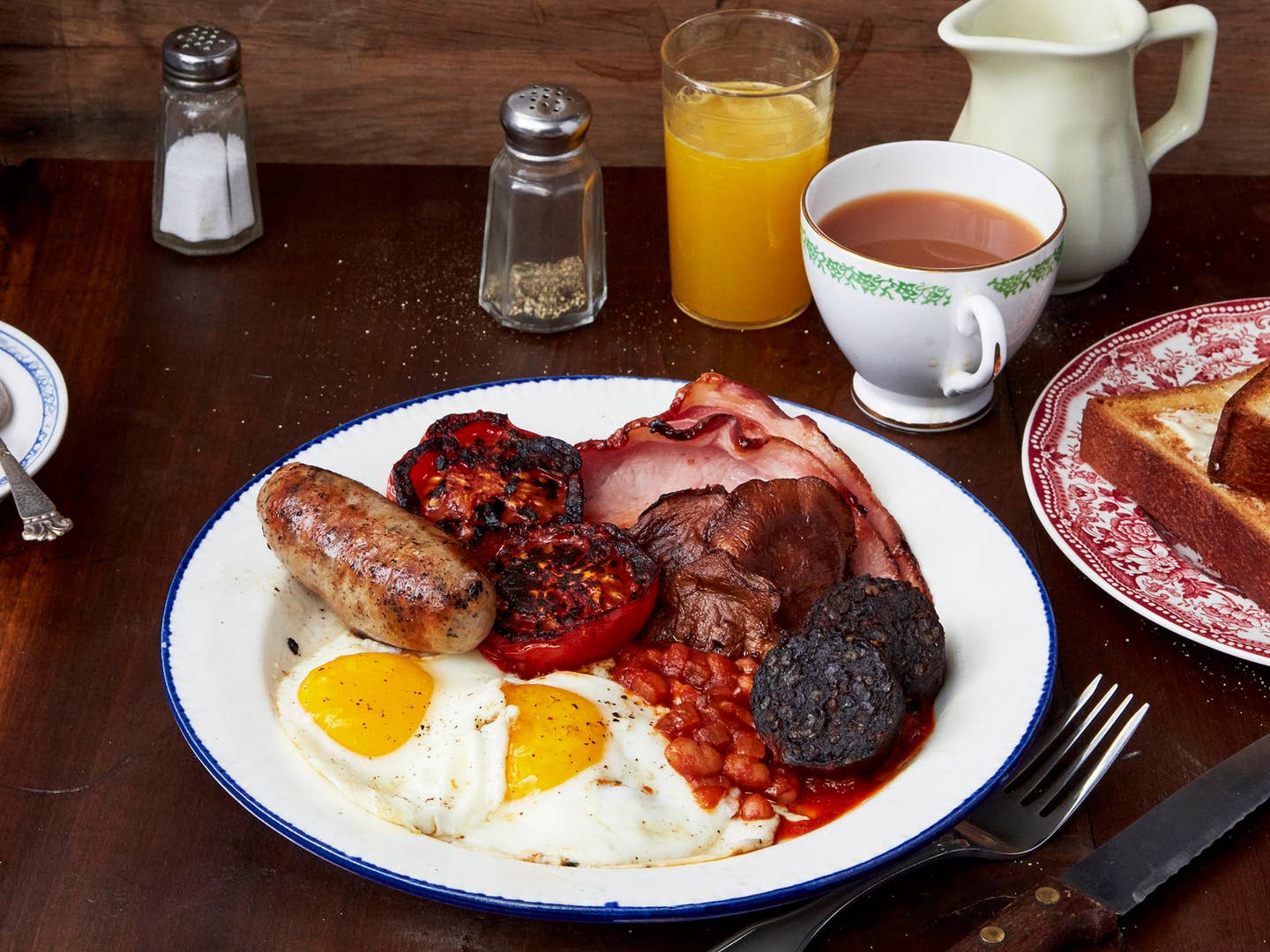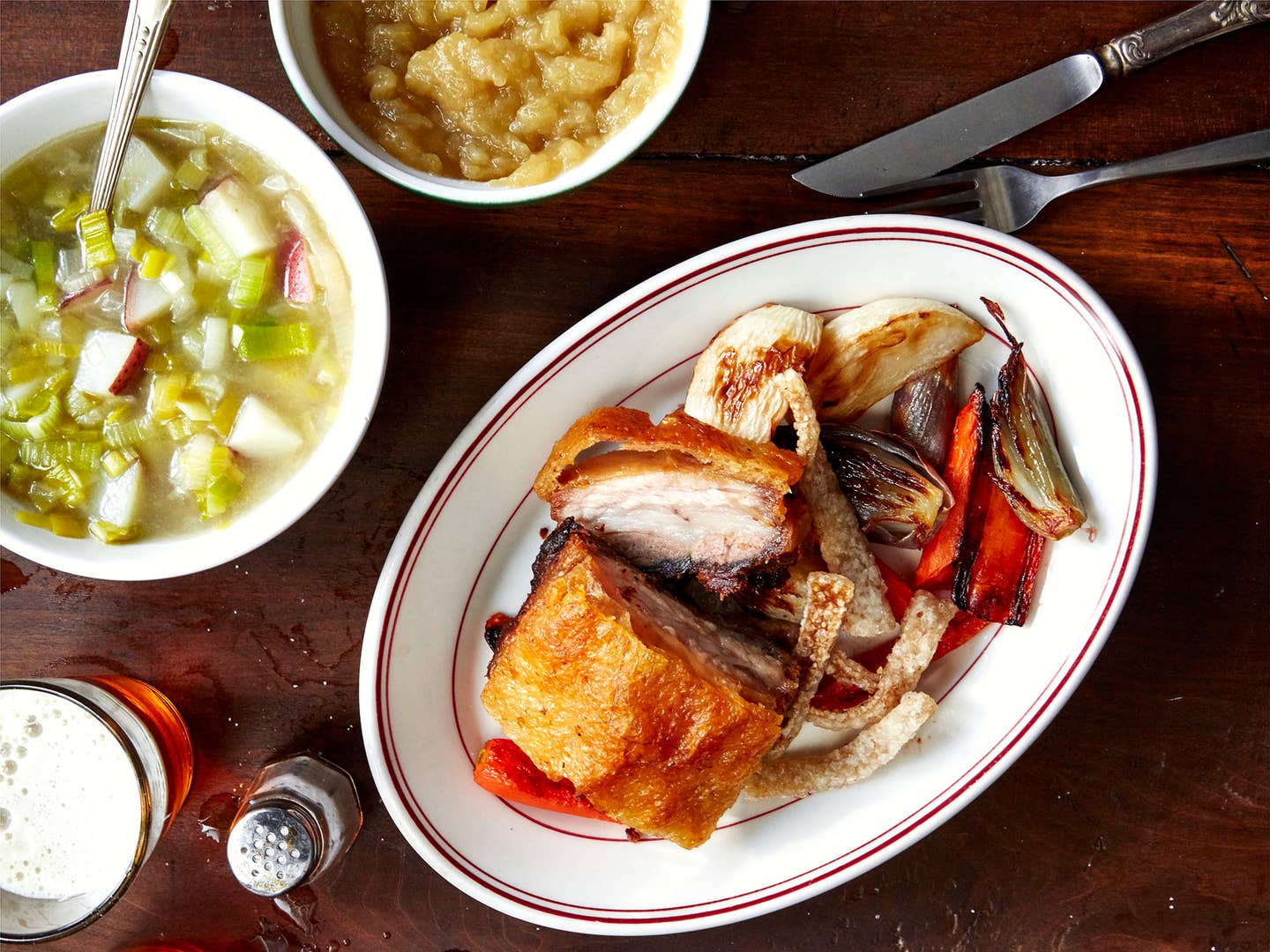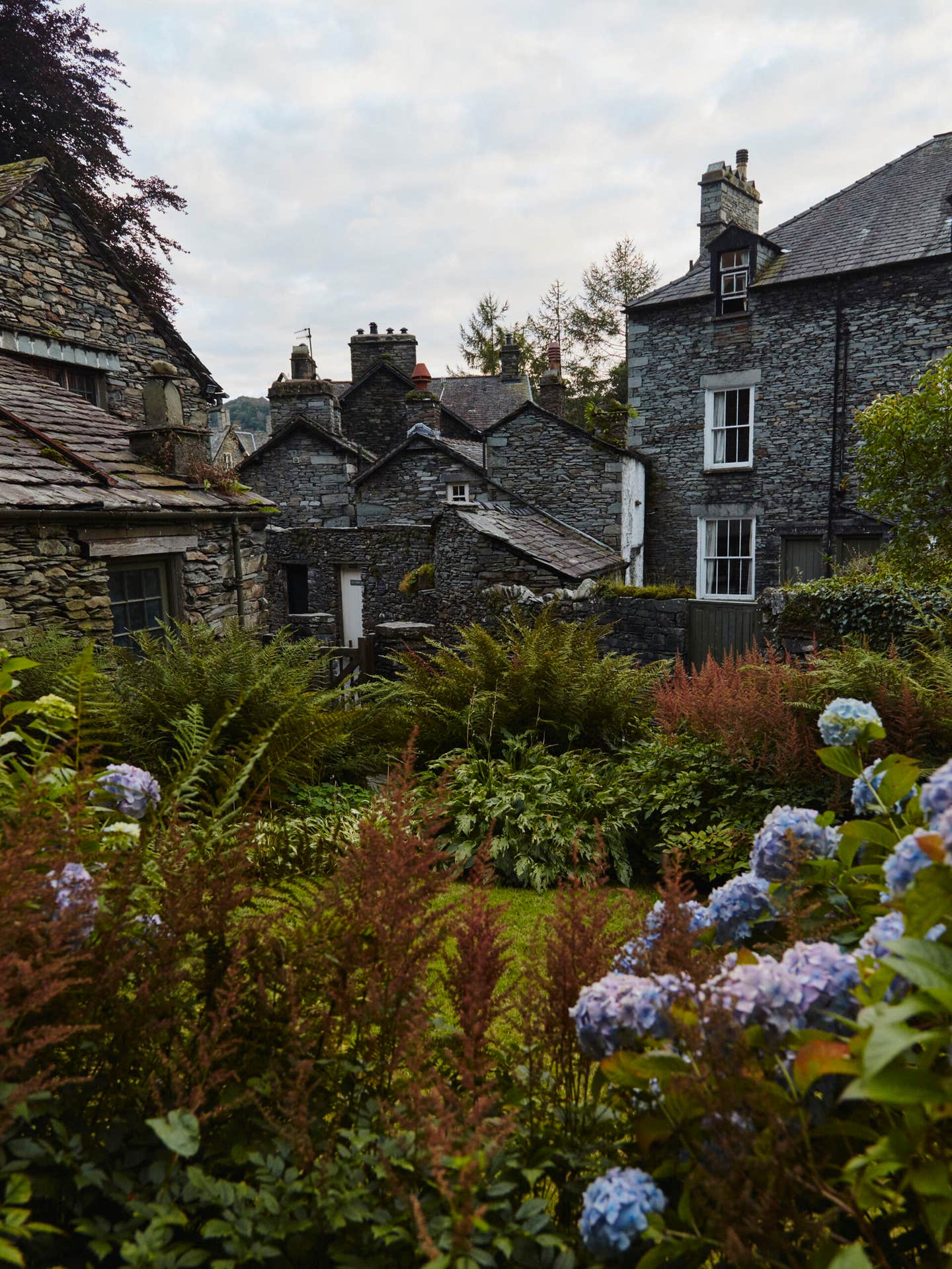
Go Walk (and Eat) in England’s Wordsworth Country
Rosie Schaap revisits the fairytale towns and green vales of England’s Lake District, where the food is now as much of a draw as the lush, romantic landscape
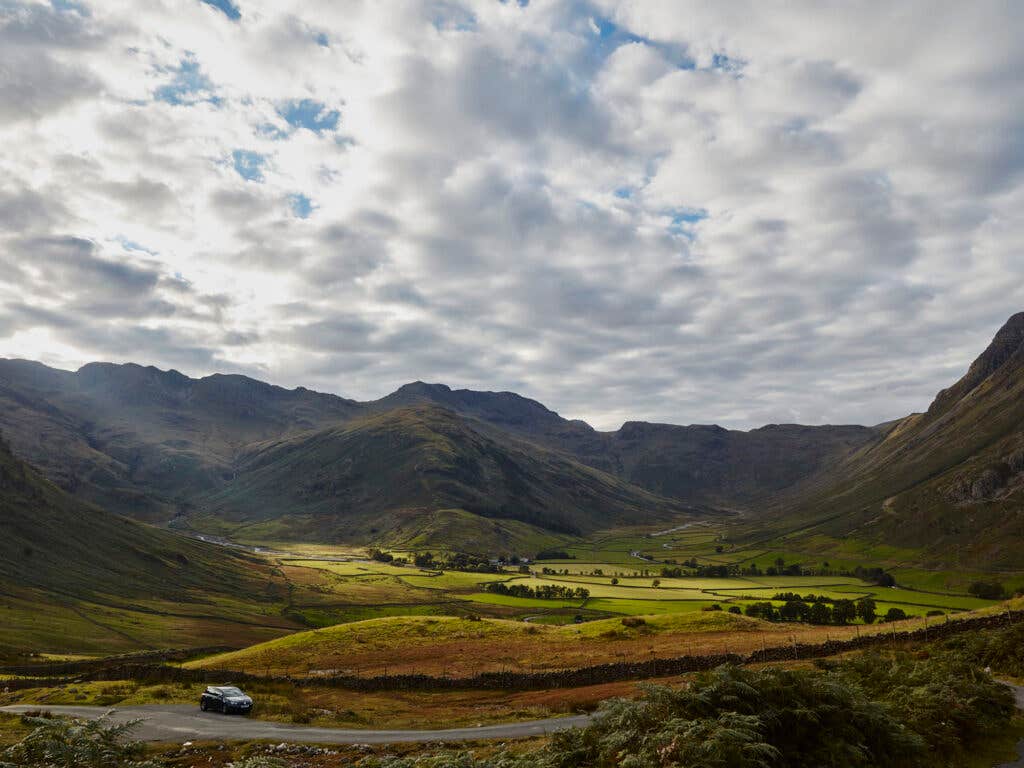
It calls to mind unreal places: Tolkien's Middle Earth, innumerable iterations of fairyland. It is unlike anywhere I've ever seen—and, more to the point, unlike any place I've ever felt. I know nowhere quite so lushly green, so exquisitely gentle here, and craggily forbidding there. It had been more than a decade since I'd visited England's Lake District, just south of the Scottish border, and even to imagine being back there without my husband, Frank, who died in 2010 of a rare form of cancer, was for a long time not possible. But last year, I felt ready.
If England were a play, the climate would be a main character. Not as predictable as its reputation, it is capricious, and its machinations frequently drive the plot. The Monday afternoon I alit from the train in the Lake District village of Oxenholme, I couldn't believe my good fortune: The sun shone so brightly that it made me laugh in happy disbelief.
From Oxenholme, I took a short train ride to Windermere and the Old Dungeon Ghyll—the magnificently grimly named inn in the Great Langdale valley where I'd spend that night, doubtful I'd get such heavenly sunshine again during my stay in the district. This made me overzealous, determined to walk as much as possible that afternoon. I checked in—it's a cheerful place, not at all so dank and dreary as the "dungeon" in its name—threw my big backpack on the bed, loaded up a smaller one, grabbed my walking stick, and headed out through the fells. Great Langdale would be the most remote of the places I'd stay during the week, with some of the most rugged and picturesque terrain. More than two centuries later, William Wordsworth's description of it remains spot-on: "Next comes Great Langdale, a Vale which should on no account be missed by him who has a true enjoyment of grand separate Forms composing a sublime Unity, austere but reconciled and rendered attractive to the affections by the deep serenity that is spread over everything."
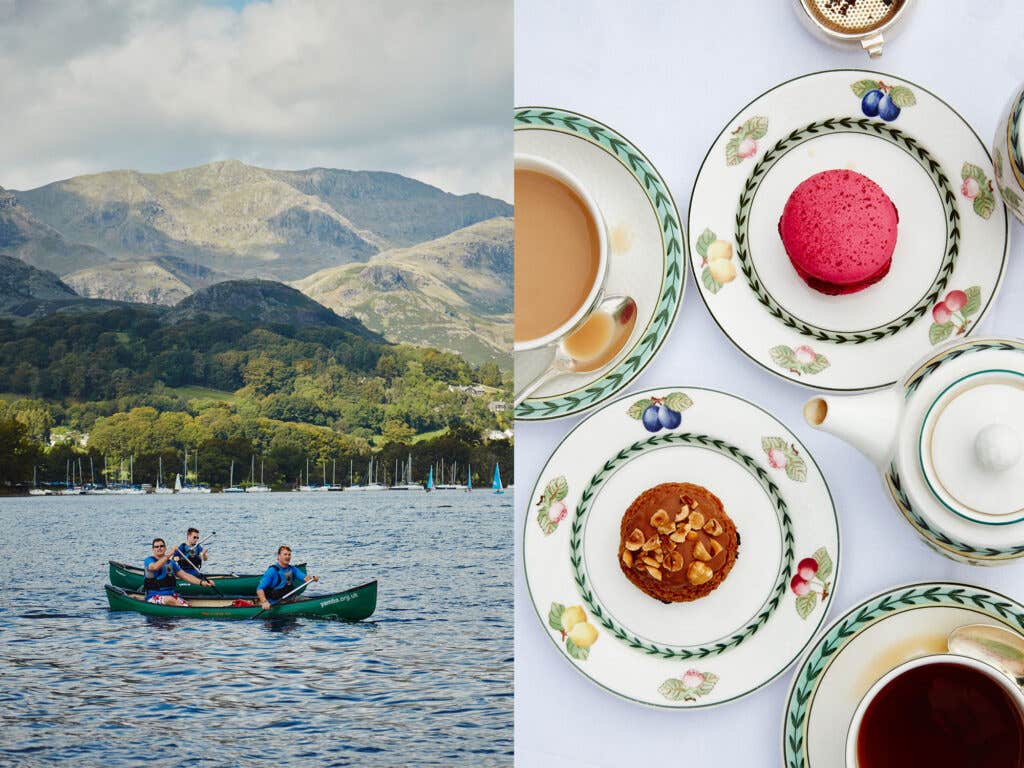
Frank and I met as grad students studying English literature. I was a Romanticism hard-liner: Ever since a William Blake seminar in college, English Romantic poetry was to me something like the literary equivalent of The Clash—the only literature that mattered. Frank was on the fence, splitting his allegiance between Modernists like T.S. Eliot and Ezra Pound, and the Romantics, especially Wordsworth. I campaigned to bring him out of the shadows: Modernists were joyless, neurotic, sexless fascists, I argued, as only a twenty-something committed to the infallibility of her opinions can. The Romantics, on the other hand, were wild and free and visionary, suffused by the spirit of revolution that animated their era. Frank finished his PhD. I did not. Still, my lobbying was so successful that we spent part of our honeymoon in that great green heartland of English Romanticism, the Lake District.
At the time, one did not go to the Lakes to eat. Instead, what one did in the district was walk, and we walked each day until we could walk no more—on the historic coffin trail, used long ago to bring the dead from the district's villages for burial at Saint Oswald's, between Grasmere and Ambleside, above Rydal Water, passing right by Dove Cottage, Wordsworth's former home. Down quiet lanes. Up steep hills. Around the lake that gives Grasmere its name. Our reward each evening was a simple, filling meal at one or another local pub—a roast with Yorkshire pudding one night, fish and chips the next—and plenty of pints of English ale.
A few years later, when we returned to the Lake District for a week, we shared a cottage outside Grasmere with friends. It had a large, well-equipped kitchen in which we roasted local Herdwick lamb and potatoes, made big salads, and ate very well while the formidable rains of Northern England percussed the roof and “our” herd of Herdwicks—they came with the cottage—bleated in the yard.
After an absence of many years, neither the district's beauty, nor the powerful emotions it elicits, had changed. But the food had. Now, the Lake District is for many visitors as much a destination for fine dining as it is for hiking and literary pilgrimage. Pride in local ingredients and attention to detail is evident, at both cozy old pubs and destination restaurants. And in the Lake District, it is advisable—I would say even essential—to experience both, to encounter the earthy and the ethereal, the cultivated and the just-as-it-is.
I mean it in the best possible way when I say that Hikers Bar—the pub at Old Dungeon Ghyll in the Great Langdale valley—smelled like wet dogs and hops. There seemed to be nearly as many dogs as there were people in the bare-bones room—a few rickety wooden tables, some timeworn chairs and benches, a great old hearth in which no fire had been lit, its mantle strewn with books and maps. I asked John, the knowledgeable, friendly (if deadpan) barman, to recommend a good local ale. He pulled me a pint of Bowness Bay Brewing Company's Swan Blonde. This crisp, hoppy (but not astringent) beer went down easy. I limited myself to one. There were other ales to try, and it was early yet.
I also asked John to recommend something to eat, and without hesitating he pointed to a special on the menu: roasted lamb shoulder, with chips and peas. I took my pint to the terrace and waited for my dinner. The lamb had the strong, distinctive flavor I remembered from the Herdwick that Frank and I had roasted years earlier. The meat was tender, its crust brown and crackled. It came with enough dark, deeply lamby gravy to coat it—and, better still, to dip the chips in (I even sloshed my peas around in it). As the night grew colder, I repaired inside and drank a pint of Yates Cumbria bitter while I sat by myself listening to the din of other hikers and admiring their intrepid, knackered dogs.
My plan was to alternate pub nights with long, luxurious lunches at the district's eminent restaurants. Holbeck Ghyll is an imposing old hunting lodge set high above Lake Windermere, in park-like grounds with intoxicating views across the water. There is nothing like marching into such a refined place in one's hiking boots, with an overstuffed pack strapped to one's back, and a walking stick in hand. Tom, the maître d', showed me to a table in the nearly empty wood-paneled dining room. My fellow diners—a young Irish woman and an Australian woman I'd met in the lounge and a couple from London—and I couldn't resist talking to each other, even though it made us feel like disobedient schoolchildren.
As my lunch started with a small portion of squash bisque with Gruyère, Tom silently, expertly deployed a starched white napkin to dispatch some bees that had gathered menacingly by the high windows near my seat. The most impressive course was baby pig loin, its richness lightened by a vivid green onion oil and the herbaceous crunch of fried sage leaves, served with pork confit, a black pudding, and a pork terrine. It was a beautiful and memorable lunch, but its formality—and the memories of Frank summoned by that dish, of the pork he would chop into a terrine when he needed a break from his dissertation, of the fried sage leaves that he used to garnish his summer corn soup—made me feel my aloneness sharply. I wondered what he would have made of this place, and its cooking, and wondered how different my experience of all this would have been with him.
Crisp Pork Belly with Roasted Vegetables and Applesauce
The skin on this slow-roasted pork belly gets peeled off and fried into cracklings, allowing the fat underneath to render and caramelize. Whatever vegetables are in season—this time of year, it’s carrots, turnips, and leeks—pair well with the meat, which is served with a cider-spiked applesauce and best enjoyed with a bitter ale, one of the many beers you can drink with it at the Black Bull Inn and Hotel in Coniston. Get the recipe for Crisp Pork Belly with Roasted Vegetables and Applesauce »
The Old Stamp House Restaurant in the bustling town of Ambleside is located in a building where Wordsworth had an office when he worked as a stamp distributor. Here, in its small, spare, cool subterranean rooms, I encountered food that tasted quintessentially English (even when classical French techniques were applied) and was exactingly regional, making use of ingredients farmed and grown right in the district and, in the case of seafood, just beyond its borders off the Cumbrian coast. The menu proclaimed its ethos: "Food Inspired by Cumbria," it said, "Heritage, People, Landscape." It's a family undertaking, the Old Stamp House. Ryan Blackburn was in the kitchen, his brother Craig, in the front of house. My lunch began with what I expected to be a homely morsel of black pudding—here, it glistened like a chocolate bonbon and was accompanied by a small, dense pool of reduced port. It was the finest black pudding I'd ever tasted: earthy, not too dry, not too moist, subtly but persuasively spiced. The lobster caught near Ravenglass (perhaps my favorite of all regional place names, the stuff of myth, or at least a Led Zeppelin song), was meltingly delicate, invigorated by zucchini and basil and sweet heirloom tomatoes. Braised pork cheek with queenies (tiny bay scallops) and purées of both artichoke and chestnut were elemental—as if earth and sea, fire and briny air, could be tasted in each bite—bordering on audacious.
Herdwick hogget—described to me as the meat of a sheep no younger than one year old and no older than two, between lamb and mutton—from Yew Tree Farm, once the property of Beatrix Potter, came cut in thick, tender pink slices, accompanied by a small pot of chanterelles and barley, suggestive of earth and woods. The word that kept coming to mind to describe my lunch was poetic, which felt hopelessly corny for a meal eaten just downstairs from Wordsworth's sometime office.
I spent that night in Hawkshead, a serene and picturesque village of whitewashed cottages and low stone buildings, a handful of fine pubs, and numerous trailheads. I had tea on my terrace at Walker Ground Manor, a bed and breakfast just five minutes' walk from the village. A small brook gurgled just beyond; behind it the deep, dark green of Grizedale Forest stretched. Between the village and Walker Ground was an entrance to a trail leading to Tarn Hows park, which Frank and I had once hiked together, and which had struck us as an apt symbol for the district as a whole. Regarded as one of its most stunning natural features, the relentlessly photographed Tarn Hows lake is not so natural as it seems: It has been touched and shaped by the human hands that merged smaller lakes into its larger whole. This is a trick the district often plays, this commingling of nature and artifice into something that feels like interdependence.
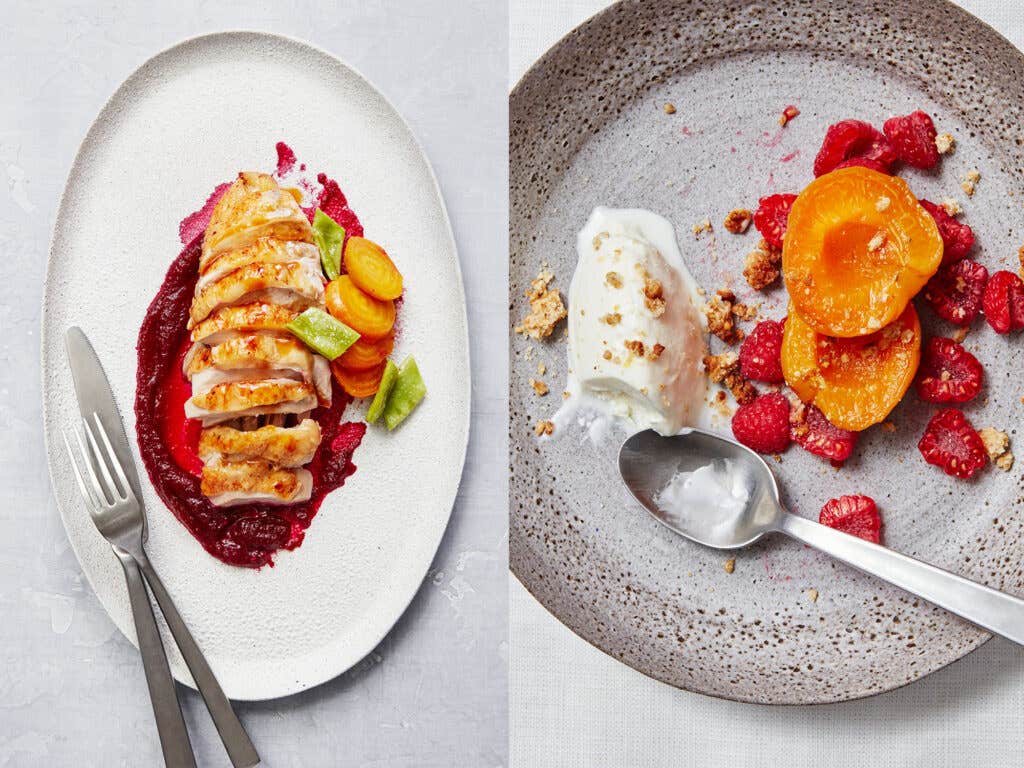
Freakishly, unaccountably, the weather had not yet failed me. The lake was still, the air nearly warm, the sky lit by blazing sunlight as a restored, steam-powered Victorian gondola ferried me to Brantwood, the onetime home of John Ruskin, the 19th-century artist, author, critic, social reformer, champion of painters including J.M.W. Turner and the Pre-Raphaelites. Ruskin pioneered ideas for which words hardly existed in his time—environmentalism, sustainability, and social justice—and his unusual and splendid home is built into the hills just across the lake from the village of Coniston. It's hard to describe this house, which began as a cottage typical of the district's vernacular architecture, but which Ruskin adapted and added to until the effect was nearly Italianate, with a few turrets almost in the Tudor fashion. It is entirely its own strange, singular place—not a mansion, not stuffy, not formal, only reflective of the deeply personal, discerning taste of its onetime owner and presiding spirit. The London-born, widely traveled Ruskin felt most at home in the Lake District. He was offered burial in Westminster Abbey, and declined it in favor of St. Andrew's churchyard in the center of Coniston village.
After visiting with him there, I sat outside the Black Bull Inn and ate an unfussy, satisfying dinner of crisp, fatty pork belly on a bed of roasted vegetables and drank a few pints of Coniston Brewing Company's famous Bluebird Bitter ale, spicy and tart and faintly floral. I thought I'd spend the evening in solitude, reading Ruskin and writing postcards and drinking, but the Black Bull is as popular with locals as it is with tourists, and pretty quickly my table filled up with Coniston characters: high school girls just after a run, a pub chef in his off-hours (his mother showed up, too), a waitress from another pub. I put the book and postcards away. They had plenty of friendly questions for me. "I'd give anything to live in New York," one of the girls said with a big, dramatic sigh. I was tempted to offer her a trade.
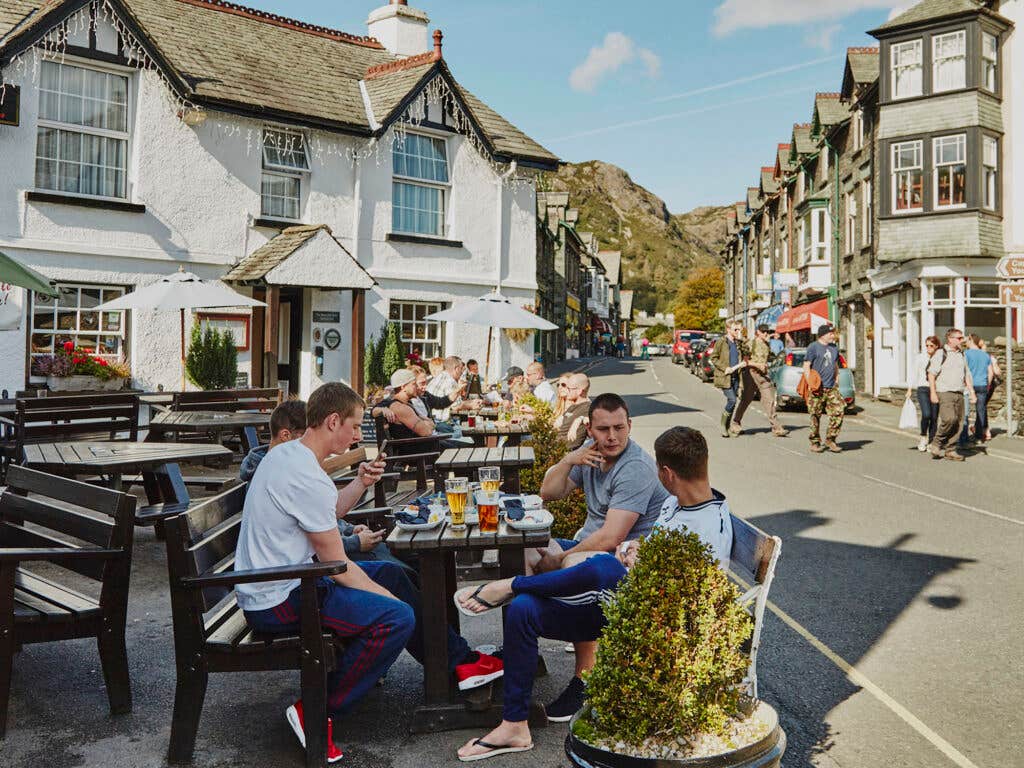
L'Enclume is regarded as the best restaurant in all of the English north, and from the second I entered it, I fell in love. Bright and airy, with exposed timber beams and pale slate floors, it has a mix of rustic charm and modern refinement that imparts an enveloping sense of calm.
I opted for the six-course lunch rather than the seventeen, and each bite yielded exceptional pleasure. A plate of short-horn beef tartare was more than merely meaty: The surprise of charcoal oil, a flavor entirely unfamiliar to me until then, made the dish new. Every mouthful of guinea fowl with runner beans and beets delivered a multitude of textures—soft and crunchy, smooth and rough—and contrasting flavors, yet was ingeniously comforting. Most memorable of all was L'Enclume's salt-baked carrot swimming in a vivid carrot broth with a small, rich, pork-fatty dumpling at the center and a few savory slices of hen-of-the-woods mushrooms rounding it out. It was both beautiful to behold and astonishingly excellent to eat. Desserts, too, were both strong and subtle. One was an ice cream made with sweet cheese, its tanginess amplified by apricot and raspberry sauces applied to the plate like bold brushstrokes; a few edible flowers added to its painterly appeal.
I had planned to stay in the district one more night, but that was no longer possible. My lunch at L'Enclume had to be the last thing I tasted in the Lakes. The best food in the Lake District shares its most prominent and memorable traits with the Romantic poetry for which the area has been long celebrated. Even at its most sophisticated, it is tightly bound to the region's natural majesty; Im thinking here, especially, of that carrot at L'Enclume. Even at its most cultivated, a streak of wildness cannot wholly be subdued.
But there was still that one thing I had to do before getting on a train to London: I had not been back to Wordsworth's beloved Grasmere. He called Grasmere, located in the center of the district, “the loveliest spot that Man hath ever found,” and the poet lies buried in the small churchyard beside Saint Oswald's, a modest stone building where worshippers still convene on Sunday mornings. I could not leave the Lakes without revisiting his grave.
I wanted to thank him for writing, among other things, the poem that comforts me most, and which I reach for often. For introducing me to this sanctified corner of the world before I'd ever even stepped foot on it. I'd probably never have eaten lunch at L'Enclume were it not for Wordsworth—or fallen in love with Frank, with whom I'll always share the Lakes. I'll quietly recite this cherished portion of his Ode: Intimations of Immortality from Recollections of Early Childhood—
Though nothing can bring back the hour
Of splendour in the grass, or glory in the flower;
We will grieve not, rather find
Strength in what remains behind
—strap my pack on my back and head for the next train out.
Recipes From Wordsworth County
See the recipe for Roasted Guinea Hens with Spring Beets and Runner Beans »
See the recipe for Sweet Cheese Ice Cream with Apricots, Raspberries, and Honey Granola »
See the recipe for Huntsman Pies »
See the recipe for Full English Breakfast with Cumberland Sausage »
See the recipe for Crisp Pork Belly with Roasted Vegetables and Applesauce »
How to Eat the Lake District
The Black Bull Inn and Hotel
1 Yewdale Rd, Coniston
+44 1539 441 335
The Coniston Brewing Company
Coppermines Rd, Coniston
+44 1539 441 133
Holbeck Ghyll Country House Hotel
Holbeck Lane, Windermere
+44 1539 432 375
L'Enclume
Cavendish St, Cartmel
+44 1539 536 362
The Old Dungeon Ghyll
Great Langdale, Ambleside
+44 1539 437 272
Old Stamp House Restaurant
Church St, Ambleside
+44 1539 432 775
The Queen's Head Inn
Main St, Hawkshead
+44 1539 436 271
Keep Reading
Continue to Next Story
